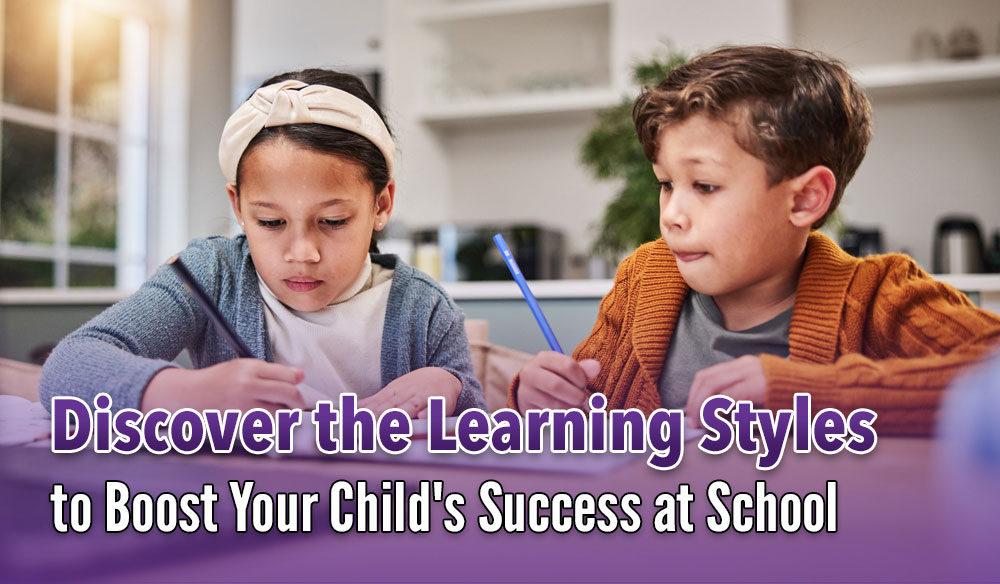Discover the Learning Styles to Boost Your Child’s Success at School
Ben was great at reading and bad at math.
He left school at the age of 10 to help with the family business. Then, still a boy, he became an apprentice at his brother’s newspaper. Despite his unconventional approach, which included experiential education through work, Ben loved words and reading, although he never returned to school.
Thomas struggled in school; he battled hyperactivity and some hearing loss. Frustrated administrators kicked him out because he didn’t fit in. His mother, furious at the teacher who basically told her he was too stupid to learn, homeschooled him from then on.
Another misfit in the classroom, Albert was said to have a mind that wandered freely rather than focus. The boy’s teacher told his father that he was “mentally slow, unsociable and adrift forever in his foolish dreams.” 1
Everyone learns differently. Successful individuals have learned to play to their strengths and overcome adversity, even if misunderstood. Such is the case with these three boys, who grew up to be world changers.
They were Ben Franklin, Thomas Edison, and Albert Einstein.
When it comes to school, for so many years, decades really, we had no idea how the sausage was made. Parents sent their kids to neighborhood schools in America, confident of the quality of education they would receive. Sure, some struggled, but the personal attention of educators, working closely with families, often found a remedy for the challenges.
Then came 2020. We were treated to the unholy image of the sausage being made. It was alarming and explained why test scores in recent years have tanked in our great land.
Part of what makes great sausage, though, is understanding the ingredients and how they work together, but we’ll drop the analogy here; it’s run its course.
It’s vital not only to make improvements to our schools, which have begun in this new Golden Era, but also to understand the gifts and opportunities our children have so that we can offer them a leg up in life, whether they are attending public, private, charter, or homeschool.
There’s a quote that’s often misattributed to Einstein. Though not from him, my hat is off to whoever said it:
“Everybody is a genius. But if you judge a fish by its ability to climb a tree, it will live its whole life believing that it is stupid.”
Why Your Child’s Learning Style Matters
My daughter used to doodle while the teacher was talking in middle school. I found this out at a parent-teacher conference. I planned to give my girl a talking to about paying attention and putting down the pencil during instruction time. To my surprise, however, Mrs. Green informed me that Emily actually listened better when she doodled, and so it would be allowed. Not what I expected, but sure enough, over time I’ve learned that my daughter does best when she is doing something with her hands – whether in school, church, or elsewhere. She fidgeted her way through high school, college, and now works in the animation industry. Go figure.
She is an example of using a learning style to advantage.
Understanding your child’s learning style equips you and them to tackle their schooling with an eye to success rather than survival. It might seem like a win for a child to dutifully sit still and not talk too much. Still, they may be missing out on a more comprehensive educational experience. Knowing how each person understands and ingests information best can be a key to success. It won’t hurt you, as a mom, to understand yours as well.
A quick internet search will provide lots of different learning philosophies. Some say there are four, while others expand the styles to seven or more. Some declare that learning styles simply don’t exist. Most of us can identify our own bent and preference for learning, so we will take a look at the four most often cited learning styles.
Four Types of Learners
Learning theories can branch into personality, temperament, gender, birth order, and many other complexities of individuals. As we consider the four learning styles, it’s worth noting that a person may engage with elements of all four; however, one is generally the most effective and most frequently used. They are Visual, Auditory, Read/Write, and Kinesthetic.
The daughter I described above is kinesthetic, while I am auditory. We’ll delve into the characteristics of each and explore how you can utilize them. Schools are often unable to change the entire methodology to accommodate each child’s specific learning style; however, you can help them learn to approach homework and study, maximizing their efforts by leaning into their strengths. It can equip your child to build a strategy for their own success, with your help along the way.
Visual
Children who are visual learners tend to retain information more effectively when it is associated with objects they can see. One may struggle, having been assigned 30 pages to read in a single night. She doesn’t know how she’ll get through it and wishes she could watch a video on the topic instead.
They may learn well from videos, images, flashcards, timelines, and graph-style representations. If your child is a visual learner, they may at times seem like their head’s in the clouds because they are trying to assign mental pictures to whatever you told them. When you tell your child to go get the notebook from their bedroom, you might add that it’s the red, spiral notebook that’s on their dresser. Give them a few seconds to picture the red notebook and the dresser. That’s how they process. That internal picture clarifies instructions for the visual learner.
Auditory
I may have been a kid who talked too much in class. My best friend and I may have had to be separated because we couldn’t stop. What can I say?
If you have an auditory child, they learn by hearing and talking. Spoken instruction is preferred over reading lengthy assignments, and they often process their world verbally. They may or may not be considered a child who “talks too much,” but they are learning and getting clarity through conversation. When studying, a child may find it useful to read their notes aloud to themselves, as hearing helps them retain the information.
Memorizing and speaking it out loud again can help implant that knowledge, making it easier to recall when it’s test time. The auditory child may even make noises to themselves while reading or working on something.
In school, they may work well in group discussions or when working with a partner to find an answer. If they have a long reading assignment for homework, you may find it helpful to discuss each section after they’ve read to help them verbally process the lesson.
Reading/Writing
This one is pretty straightforward. As the name suggests, these students thrive with reading assignments over the more social learning opportunities. They can process what they’ve learned through their copious note-taking skills and by describing concepts as they write.
The nice thing for the Reading/Writing learner is that traditional school assignments are usually geared toward their strengths. When they listen to a lecture, they are ready to take detailed notes and to read them over and over when preparing for a test.
Kinesthetic
A young boy in class struggles to sit still. He fidgets and squirms at his desk, thinking of recess in 25 minutes, and is considered a problem as he tries to survive a long class lesson; his teacher pauses periodically to give him “the look.”
These are the hands-on kids. They learn through touch, taste, movement, and activity, and have little patience for lengthy explanations of rules or instructions. They are often ready to go before being fully informed. My husband and my daughter are both in this camp, and as I’m trying to prepare the family for something we’re going to do, they are impatient. “Can we just do this?” one of them might say. Instructions are merely a backup plan for many of these go-getters.
If they can be active and learn simultaneously, they are more likely to stay engaged, like my Emily, mentioned earlier. She needs to be doing something with her hands (usually drawing) to focus. I don’t get it – but for her, it’s always worked.
As you consider these concepts, don’t miss our conversation on this week’s podcast with speaker and author, Dr. Shannon Kroner, who discussed with us the vital need to teach your kids critical thinking skills.
Figure Out How They Learn
My brief descriptions may give you a clue; however, there is much more to know, starting with how you can discover your child’s learning strengths.
-
- Observe
Watch your child at play and in other activities, including learning. Note when they are relaxed, unstressed, and engaged. You may discover that your little talker is also an auditory learner. Or that your rambunctious boy learns best through activity. Does your child love to read? That could be a clue.
-
- Test
There are online tests available to delve deeper into these concepts. The Vark Questionnaire2 aligns with the four learning styles I mentioned, and others to consider are Personality Max3 and the Learning Styles quiz4 from Colorado State University.
Another great source is author and speaker Cynthia Tobias.5 Her books, The Way They Learn, and her latest, Reclaiming Education: Teach Your Child to Be a Confident Learner, are excellent. She also has free tools on her website to help you assess your child’s learning style. To hear her share some of her wisdom, check out her interview on Focus on the Family, “Discovering Your Child’s Learning Style.” 6
-
- Try
Identify some methods that are particularly helpful for your child’s learning style and try them out. You may find your kinesthetic child enthralled by a trip to an aviation museum when he is learning about the history of flight. Your auditory learner may enjoy The Hiding Place in audiobook format when learning about World War II. Watching a movie at home with you, about a topic related to a current subject in science class, may open a new world to your visual child. See what works – and note what doesn’t.
We have barely scratched the surface of this topic, but we hope it inspires you to find out more about your sons and daughters. Every child is unique – specially designed to be one of a kind. As moms, we have the privilege of loving and caring for our children and unraveling the mystery to help them thrive in school and in life.
***




